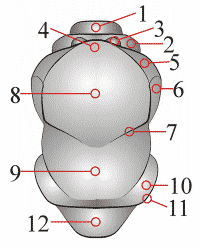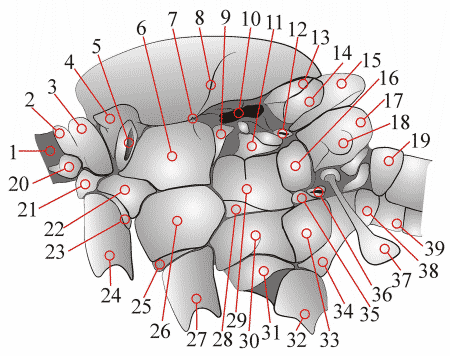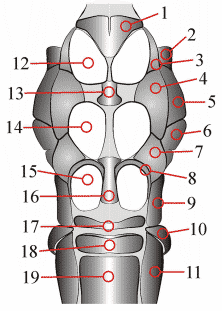
 Introduction
Introduction
 History
History
 Morphology
Morphology
 Terminology
Terminology
 Head
Head
 Antenna
Antenna
 Thorax
Thorax
 Leg
Leg
 Wing
Wing
 Abdomen
Abdomen
 Genitalia
Genitalia
 Chaetotaxy
Chaetotaxy
 Egg
Egg
 Larva
Larva
 Pupa
Pupa
 Addition
Addition
 ESEM
ESEM
 Glossary
Glossary
 Phylogeny
Phylogeny
 Distribution
Distribution
 Ecology
Ecology
 Biology
Biology
 Collecting
Collecting
 Determination
Determination
 Photography
Photography
 References
References
|
|

Fig. 1: thorax, dorsal
|
|
|
Fig. 1:
|
|
1 = |
antepronotum, aprn; anterior antepronotum [1+8]; anterior pronotum [1/3]; anterior pronotum [8]
|
|
2 = |
postpronotum, pprn; posterior antepronotum [1+8]; posterior pronotum [1/3]; anterior pronotum [8]
|
|
1+2+5 |
=
pronotum, prn [1]
|
|
3 = |
mesoanterior angle of postpronotum and a mesonatal apodeme between the two lobes in almost all Leptogastrinae; in Euscelidia an additional postpronotal peg [1+8]; mesoanterior angle of posterior pronotum and a mesonotal pit between the two lobes in almost all Leptogastrinae; in Euscelidia an additional peg [8]; pronotal lobe of Leptogastrinae between which lies the central mesonotal pit [Dikow pers. comm.]
|
|
4 = |
prescutum, presct [1/7]
|
|
5 = |
postpronotal lobe, pprn lb; humerus (pl. humeri); humeral callus [1]; postpronotum [7]; humeral callus = posterior area of posterior pronotum [8]
|
|
6 = |
notopleuron, npl; paratergite [7] [better: Cannings, 2002]
|
|
7 = |
transverse suture, trn sut [1/7]
|
|
8 = |
presutural area of scutum, presut area
|
|
9 = |
postsutural area of scutum, psut area; scutum [7] (incorrect) [1]
|
|
8+9 = |
scutum, sct; mesonotum (* incorrect) [1]
|
|
10 = |
postalar callus, pal cal [1]; parascutellum [7]
|
|
11 = |
postalar wall, pal wal; postalar declivity [1]
|
|
12 = |
scutellum, sctl [1/7]
|
|
* |
mesonotum = prescutum (reduced in Diptera) + scutum + scutellum + postnotum (= metanotum, postscutellum) [1]
|
|

Fig. 2: thorax, lateral
| |
Fig. 2:
1 = cervix, cerv [1]. -
2 = antepronotum, aprn; anterior antepronotum [1+8]; anterior pronotum [1/3]. -
3 = postpronotum, pprn; posterior antepronotum [1+8]; posterior pronotum [1/3]. -
4 = postpronotal lobe, pprn lb; humeri [1]; humeral callus [3]; postpronotum [7]. -
5 = mesothoracic spiracle, mes spr; anterior spiracle [1/6]; prothoracic spiracle [5]. -
6 = anepisternum, anepst [1/7]; upper part of episternum [1]; anepisternum 2 [3/4]; mesopleuron [1/5/6]. -
7 = anterior notal wing process ? [1]. -
8 = transverse suture, trn sut; transscutal suture; scutal suture (incorrect) [1]. -
9 = anterior & posterior basalare [1]; basalare 2 [3]; anterior basalare [Cannings, 2002]. -
10 = wing base, wg bs [1]. -
11 = pleural wing process, plr wg proc; subalare? [7]; subalare 2? [3]; posterior basalare [Cannings, 2002]. -
12 = ? [1]. -
13 = postalar callus, pal cal [1]; posterior callus [5]; parascutellum [7]; postalar callosity [Cannings, 2002]. -
14 = postalar wall, pal wal; postalar declivity [1]. -
15 = scutellum, sctl [1]; mesoscutellum [5]. -
16 = katatergite (part of mesopostnotum), ktg; ventral portion of laterotergite [1/4]; laterotergite of postnotum [3]; mesepimeron [5]. -
17 = mesopostnotum (mediotergite + laterotergite), mes pnot; mediotergite [1/7/Cannings, 2002]; anterior portion: subscutellum or postscutellum [1]. -
18 = anatergite (part of mesopostnotum), anatg; dorsal portion of laterotergite [1/4]; slopes of postmesonotum [5]; postnotal callus [6]. -
19 = abdominal tergite 1, abd tg 1 [1]. -
20 = 2nd cervical sclerite, cerv scl 2 [1/3]; 2nd laterocervical sclerite; lateral cervicale [7]. -
21 = proepisternum, prepst, anterior propleuron [1]; episternum [3]; propleuron [5]; precoxal bridge [7]. -
22 = proepimeron, prepm; posterior propleuron [1]; epimeron 1 [3/4]. -
23 = ? [1]; precoxale 1. -
24 = coxa 1 (pl. coxae), cx 1 [1]; precoxa. -
25 = ? [1]; precoxale 2. -
26 = katepisternum, kepst [1/7]; lower part of episternum; sternopleuron; sternopleurite; preepisternum [1]; mesosternum (incorrect) [3]; katepisternum 2 [4]; sternopleuron 2 [5/6]. -
27 = coxa 2, cx 2 [1]; mesocoxa. -
28 = katepimeron, kepm; barrette [1]. -
29 = anepimeron, anepm [1/7]; epimeron 2 [3]; pteropleuron [1/5/6]. -
30 = meron, mr [1/7]; meropleuron; hypopleuron [1/3/4/5/6]; remark: usually fused with metepisternum. -
31 = metkatepisternum, mtkepst 3; precoxale [4]. -
32 = coxa 3, cx 3 [1]; metacoxa. -
33 = metanepisternum, mtepst; episternum 3 [3/4]; mesepisterum [5]; remark: usually fused with meron. -
34 = metepimeron, mtepm [1/5]; epimeron 3 + notum 3 [3]; epimeron 3 [4]. -
33+34 = metapleuron [1]. -
35 = katepimeron, kepm [1]. -
36 = metathoracic spiracle, met spr [5]; posterior spiracle [1/6]. -
37 = halter, hlt [1]. -
38 = abdominal sternite 1, abd st 1 [1]. -
39 = abdominal sternite 2, abd st 2 [1].
|

Fig. 3: thorax, ventral
|
|
1 = |
prosternum, prst; precoxal bridge, if it is joined with proepisternum [1/6/7]
|
|
2 = |
postpronotal lobe, pprn lb; humeri [1]; humeral callus [3/5]
|
|
3 = |
proepimeron, prepm; posterior propleuron [1]; epimeron 1 [3/4]
|
|
4 = |
katepisternum, kepst; lower part of episternum; sternopleuron; sternopleurite; preepisternum [1]; mesosternum (incorrect) [3]; katepisternum 2 [4]; sternopleuron 2 [5/6]
|
|
5 = |
anepisternum, anepst; upper part of episternum [1]; anepisternum 2 [3/4]; mesopleuron [1/5/6]
|
|
6 = |
anepimeron, anepm and katatergite [1]
|
|
7 = |
meron, mr; meropleuron; hypopleuron [1/3/4/5/6]
|
|
8 = |
? [1]; precoxale [4]
|
|
9 = |
metepimeron, mtepm [1/5]; epimeron 3 + notum 3 [3]; epimeron 3 [4]
|
|
10 = |
abdominal tergite 1, abd tg 1 [1]
|
|
11 = |
abdominal tergite 2, abd tg 2 [1]
|
|
12 = |
front coxal foramen [-]; front coxal cavity [5]
|
|
13 = |
mesosternum [1]; sternopleuron of mesothorax [5]
|
|
14 = |
mid coxal foramen [-]; mid coxal cavity [5]
|
|
15 = |
hind coxal foramen [-]; hind coxal cavity [5]
|
|
16 = |
? [1]; mesoepisternum + metepisternum [5]
|
|
17 = |
metasternum, = postcoxal bridge ? [1/5]; remark: this sklerite is not known from all robber flies and further studies have to clearify it
|
|
18 = |
abdominal sternite 1, abd st 1 [1]
|
|
19 = |
abdominal sternite 2, abd st 2 [1]
|
|
References
[1] McAlpine, J.F. (1981): Morphology and terminology - Adults. - In: McAlpine, J.P. et al. (eds.): Manuel of Nearctic Diptera, vol. 1; p. 9-63 - Ottawa: Research Branch, Agriculture Canada, Monograph 27.
[2] Hull, F.M. (1962): Robber flies of the world, 2 volumes; 907 pp. - Washington: Bulletin of the United States National Museum 224 (1,2).
[3] Cole, F.R. & Pritchard, A.E. (1964): The genus Mallophora and related asilid genera in North America (Diptera: Asilidae). - University of California Publications in Entomology 36: 43-100, 4 pls.; Berkeley - Los Angeles.
[4] Fisher, E. (1986): A reclassification of the robber fly tribe Andrenosomini, with a revision of the genus Dasyllis Loew (Diptera: Asilidae); 361 pp. - Riverside: Ph.D. thesis, University of California.
[5] Artigas, J.N. (1967): The Asilidae (Diptera) of Chile, 2 Vols. - Xerography of Doctoral Diss., University Microfilms: 674 pp.; Ann Arbor.
[6] Theodor, O. (1980): Fauna Palaestina - Insecta II - Diptera: Asilidae; 446 pp. - Jerusalem: The Israel Academy of Science and Humantities.
[7] Crampton, G.C. (1942): Guide to the insects of Connecticut. Part IV. The Diptera, or true flies of Connecticut. The external morphology of the Diptera. - Bulletin of the Connecticut Geological and Natural History Survey 64: 10-165; Hartford.
[8] Martin, C.H. (1968): The new family Leptogastridae (The Grass Flies) compared with the Asilidae (robber flies) (Diptera). - Journal of the Kansas Entomological Society 41(1): 70-100; Manhattan - Lawrence.
|



|